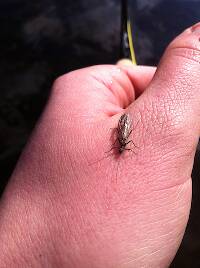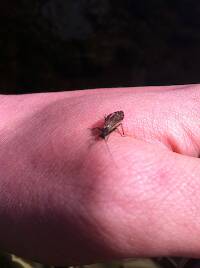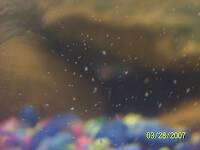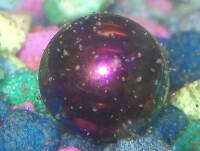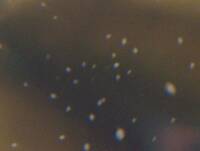
Hex Mayflies
Hexagenia limbata
The famous nocturnal Hex hatch of the Midwest (and a few other lucky locations) stirs to the surface mythically large brown trout that only touch streamers for the rest of the year.
Featured on the forum
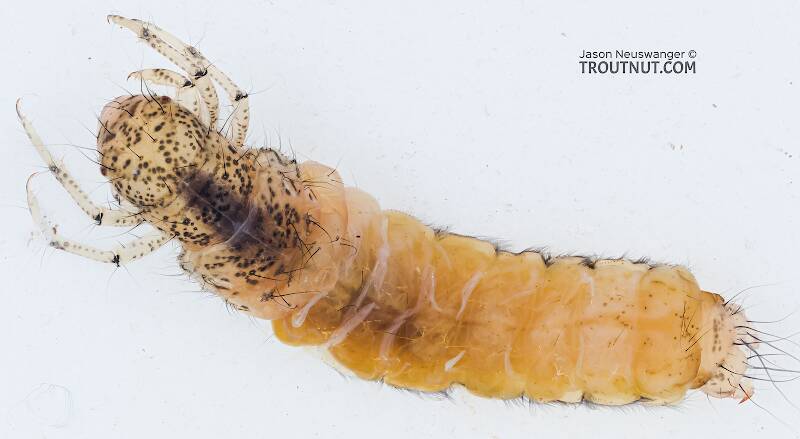
This is a striking caddis larva with an interesting color pattern on the head. Here are some characteristics I was able to see under the microscope, but could not easily expose for a picture:
- The prosternal horn is present.
- The mandible is clearly toothed, not formed into a uniform scraper blade.
- The seems to be only 2 major setae on the ventral edge of the hind femur.
- Chloride epithelia seem to be absent from the dorsal side of any abdominal segments.
Based on these characteristics and the ones more easily visible from the pictures, this seems to be Grammotaulius. The key's description of the case is spot-on: "Case cylindrical, made of longitudinally arranged sedge or similar leaves," as is the description of the markings on the head, "Dorsum of head light brownish yellow with numerous discrete, small, dark spots." The spot pattern on the head is a very good match to figure 19.312 of Merritt R.W., Cummins, K.W., and Berg, M.B. (2019). The species ID is based on Grammotaulius betteni being the only species of this genus known in Washington state.
- The prosternal horn is present.
- The mandible is clearly toothed, not formed into a uniform scraper blade.
- The seems to be only 2 major setae on the ventral edge of the hind femur.
- Chloride epithelia seem to be absent from the dorsal side of any abdominal segments.
Based on these characteristics and the ones more easily visible from the pictures, this seems to be Grammotaulius. The key's description of the case is spot-on: "Case cylindrical, made of longitudinally arranged sedge or similar leaves," as is the description of the markings on the head, "Dorsum of head light brownish yellow with numerous discrete, small, dark spots." The spot pattern on the head is a very good match to figure 19.312 of Merritt R.W., Cummins, K.W., and Berg, M.B. (2019). The species ID is based on Grammotaulius betteni being the only species of this genus known in Washington state.

Troutnut is a project started in 2003 by salmonid ecologist Jason "Troutnut" Neuswanger to help anglers and
fly tyers unabashedly embrace the entomological side of the sport. Learn more about Troutnut or
support the project for an enhanced experience here.
Martinlf on Jul 6, 2007July 6th, 2007, 12:54 am EDT
Now that I'm ready to post up something other than foolishness, I can't find the thread, but somewhere John Dunn, (AKA JAD) recently mentioned olives on the Little Juniata that were smaller than size 20 and I immediately thought Acentrella (formerly known as Psuedos or Pseudocloeon). How about this as a possibility?
"He spread them a yard and a half. 'And every one that got away is this big.'"
--Fred Chappell
--Fred Chappell
GONZO on Jul 6, 2007July 6th, 2007, 7:30 am EDT
Acentrella is a possibility. But John also mentioned that they were blackish, so I'm not sure that fits. There are many baetids that are sub-#20, and they can be impossible to sort out without a microscope and good keys. (Even with those tools, I understand it can be tough.) The multiple generations make it challenging, too, because they become progressively smaller.
Taxon on Jul 6, 2007July 6th, 2007, 12:42 pm EDT
Gonzo makes a good point about many baetids being sub-#20. On the other hand, it strikes me that this thread may have potential to further all of our familiarity with the smaller baetids, particularly if a more complete description can be resurrected.
Louis mentions location (Little Juanita) and size (smaller than size 20). And, Gonzo mentions blackish. Perhaps John can supply a general date of observance, the body color and wing color, and which lifestage (dun or spinner). With this information, perhaps we can (at least) significantly narrow the possibilities. Or, not.
Louis mentions location (Little Juanita) and size (smaller than size 20). And, Gonzo mentions blackish. Perhaps John can supply a general date of observance, the body color and wing color, and which lifestage (dun or spinner). With this information, perhaps we can (at least) significantly narrow the possibilities. Or, not.
GONZO on Jul 6, 2007July 6th, 2007, 1:36 pm EDT
Honestly, Roger, I'm guessing that both Louis and I were just hoping to draw you out of the woodwork with a "bug" post! ;) It's funny how the threads can bounce back and forth between the bug geeks and the fly guys for spells, but I enjoy hearing from all of them.
Seriously, I'm not sure if we can even assume it's a baetid at this point. I was kind of leaning toward Serratella, but I won't have much to go on until John can answer the 2 tails or 3 question. (I think of deficiens as being a solid #20, but that's a pretty approximate way to refer to size.) The original thread was about early reports of tricos (and it was Louis who started it, so I'm puzzled why he can't find it), but John would know the difference, so I think we can rule tricos out.
As I recall John's post, he was describing small black spinners. It's under "PA Tricos?" (or something like that) in the general section if you want to check for yourself. There's some related discussion of other "BWOs" and a report by Konchu about a new mayfly species from Borneo (Darthus vadorus--no kidding!).
Anyway, it's good to hear from you, and I share your interest in learning more about some of the little baetids. For now, however, I guess we're waiting on John. He's probably busy catching fish or some such nonsense. :)
Seriously, I'm not sure if we can even assume it's a baetid at this point. I was kind of leaning toward Serratella, but I won't have much to go on until John can answer the 2 tails or 3 question. (I think of deficiens as being a solid #20, but that's a pretty approximate way to refer to size.) The original thread was about early reports of tricos (and it was Louis who started it, so I'm puzzled why he can't find it), but John would know the difference, so I think we can rule tricos out.
As I recall John's post, he was describing small black spinners. It's under "PA Tricos?" (or something like that) in the general section if you want to check for yourself. There's some related discussion of other "BWOs" and a report by Konchu about a new mayfly species from Borneo (Darthus vadorus--no kidding!).
Anyway, it's good to hear from you, and I share your interest in learning more about some of the little baetids. For now, however, I guess we're waiting on John. He's probably busy catching fish or some such nonsense. :)
GONZO on Jul 6, 2007July 6th, 2007, 3:30 pm EDT
Hey Roger,
I've thought of a way we can kill some time (productively, I hope) while waiting for John to report on the little J mystery mayfly. And it's not really off-topic for this thread (Tiny BWO).
I've always been curious about the egg-laying habits of little baetid spinners. Some crawl, swim, or dive (?) to lay their eggs, prompting wet-fly tactics. Some fall spent on the water in the more normal fashion. Some accounts say that it's mostly the females that fall on the water. Yet, some species are parthenogenetic, and I know I've seen photos (Ralph Cutter's, I believe) that show male spinners crawling or swimming underwater.
The accounts of which species do what are pretty sketchy. Are some of these habits variable? I know that the emergence methods of many mayfly species are not as cut-and-dried as they are often described in fly-fishing texts. Is egg-laying the same? Do the egg-layers return to the surface after underwater forays? That would seem difficult, because unlike diving caddisflies (which often do return to the surface, and, by some accounts, even mate several times), the spinners would now seem to be in a "wettable" state, unlike the water-repellent duns that have some protection.
I'm hoping you might have some insight into this, or perhaps we can motivate some of the others with bug-geeky tendencies to chime in.
I've thought of a way we can kill some time (productively, I hope) while waiting for John to report on the little J mystery mayfly. And it's not really off-topic for this thread (Tiny BWO).
I've always been curious about the egg-laying habits of little baetid spinners. Some crawl, swim, or dive (?) to lay their eggs, prompting wet-fly tactics. Some fall spent on the water in the more normal fashion. Some accounts say that it's mostly the females that fall on the water. Yet, some species are parthenogenetic, and I know I've seen photos (Ralph Cutter's, I believe) that show male spinners crawling or swimming underwater.
The accounts of which species do what are pretty sketchy. Are some of these habits variable? I know that the emergence methods of many mayfly species are not as cut-and-dried as they are often described in fly-fishing texts. Is egg-laying the same? Do the egg-layers return to the surface after underwater forays? That would seem difficult, because unlike diving caddisflies (which often do return to the surface, and, by some accounts, even mate several times), the spinners would now seem to be in a "wettable" state, unlike the water-repellent duns that have some protection.
I'm hoping you might have some insight into this, or perhaps we can motivate some of the others with bug-geeky tendencies to chime in.
Taxon on Jul 7, 2007July 7th, 2007, 3:39 am EDT
Gonzo-
About the best I can offer is a link to Ralph Cutter's article, All That Glitters, toward the end of which, he discusses the mating behavior of Baetis spinners. Don't believe I have encountered anywhere near as much detail in any other flyfishing entomology literature.
About the best I can offer is a link to Ralph Cutter's article, All That Glitters, toward the end of which, he discusses the mating behavior of Baetis spinners. Don't believe I have encountered anywhere near as much detail in any other flyfishing entomology literature.
GONZO on Jul 7, 2007July 7th, 2007, 4:22 am EDT
Thank you, Roger! That's a great article, and very revealing for a number of reasons. (The underwater photo of the bubble-bearing caddisfly pupa is a revelation in itself, and seems to resolve a twenty-year debate.) While the info on baetids is rather slight, it is very useful and answers a number of my questions.
Martinlf on Jul 7, 2007July 7th, 2007, 4:35 am EDT
Geez, any opening and I'm toast. I won't even suggest that I was simply using a manufactured excuse to start a thread focused on BWO's that would take us away from Tricos and point us directly to the more olive of their brethren, nor will I mention the possibility that since Taxon hadn't, as I had hoped he would, in any way responded to the "little Latin and less Greek" post (OK Gonzo, who said that, and about whom?)my opening post was specifically designed for bug geeks, no, I woun't bring those things up, since Gonzo has already mentioned them. I also won't bring up the point that some have claimed to have sighted "Pseudos" on the Little J--Meck, Hoover--or, Bill Anderson citing one of them perhaps. But Gonzo's and Taxon's points are well taken (even though I'm not bringing up superfluous and silly points to distract from the attention their facts deserve). Now, Gonzo, about that quotation . . .
"He spread them a yard and a half. 'And every one that got away is this big.'"
--Fred Chappell
--Fred Chappell
GONZO on Jul 7, 2007July 7th, 2007, 5:27 am EDT
Louis,
Despite your apophasis/praeteritio/occupatio (yes?), I'm not doubting at all that "pseudos"/Acentrella are found on the Little J. It's just John's mention of a black spinner that makes me doubt that "A" is the genus. (But, who knows?) By the way, do read the Cutter article Taxon provided--outstanding!
As for the quotation, I believe that was said of the Bard's education by Jonson. ("To the Memory...."--so there!)
Despite your apophasis/praeteritio/occupatio (yes?), I'm not doubting at all that "pseudos"/Acentrella are found on the Little J. It's just John's mention of a black spinner that makes me doubt that "A" is the genus. (But, who knows?) By the way, do read the Cutter article Taxon provided--outstanding!
As for the quotation, I believe that was said of the Bard's education by Jonson. ("To the Memory...."--so there!)
Martinlf on Jul 7, 2007July 7th, 2007, 7:38 am EDT
Nicely done. I'll take a look at the article, and by the way, I prefer the term occupatio myself, as in occupied patio, since it was a favorite of Jerry Mills, my favorite grad school prof. :)
"He spread them a yard and a half. 'And every one that got away is this big.'"
--Fred Chappell
--Fred Chappell
Konchu on Jul 18, 2007July 18th, 2007, 3:29 pm EDT
Somehow this discussion about tiny BWOs on the Little J got past me until now. Thought I'd revive the thread and see what, if anything, I find out about the little dudes to figure out who they are.
Quick Reply
Related Discussions
Topic
Replies
Last Reply
5
Aug 20, 2009
by Flytyer0423
by Flytyer0423
6
Aug 21, 2010
by Gutcutter
by Gutcutter





